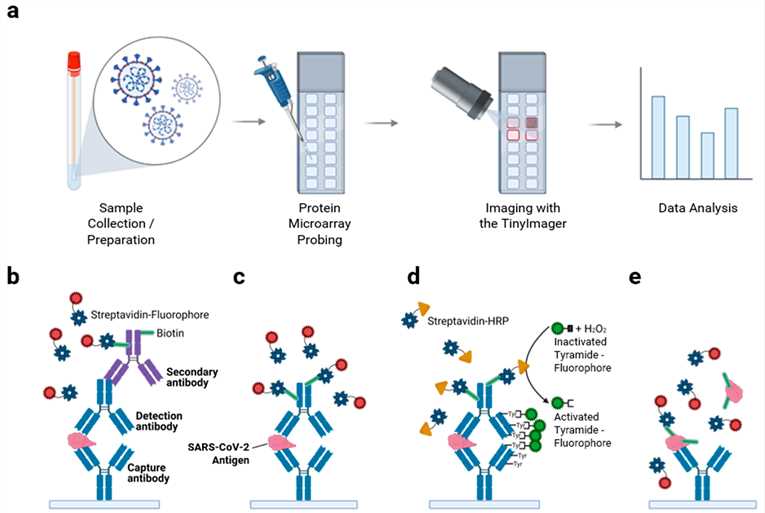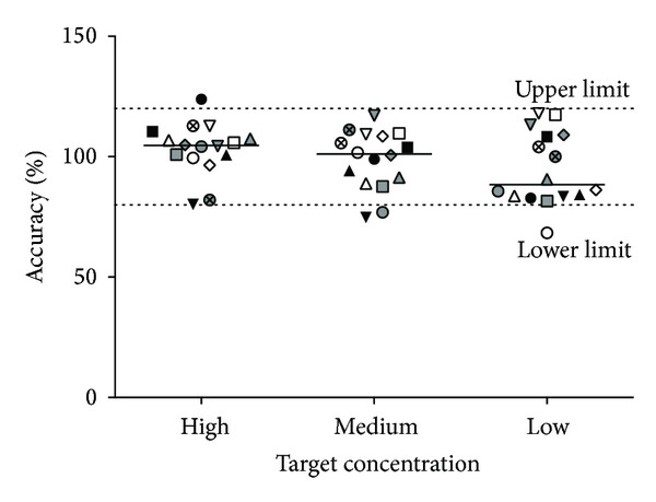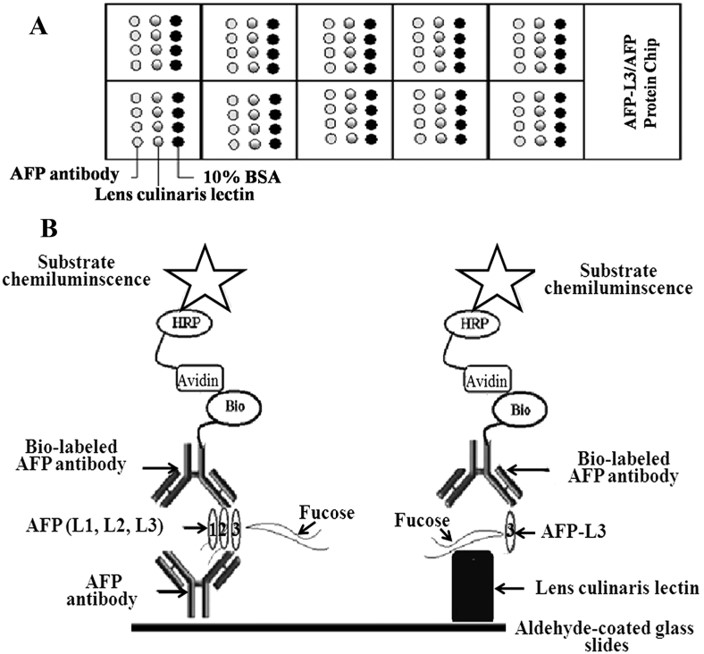Our kits facilitate the rapid and comprehensive screening of biological samples to identify novel disease-specific protein signatures, aiding in early diagnosis, prognosis, and monitoring of disease progression.
At Creative Biolabs, we are dedicated to the cutting-edge development of protein microarray-based kits, enabling the parallel tracking and analysis of vast numbers of proteins. Leveraging our profound expertise and state-of-the-art technology, we are committed to delivering high-quality, cost-effective testing solutions that are meticulously optimized to ensure the success of your critical projects.
How Does It Work?
Protein microarray technology provides a high-throughput method for tracking protein interactions, activities, and functions on a large scale. At its core is a chip, a carrier surface (e.g., glass slide, nitrocellulose membrane, bead, or microtiter plate) onto which a capture protein array is precisely bound. Labeled probe molecules are then introduced; specific reactions between the probe and immobilized protein emit a detectable signal, accurately read by a laser scanner or other specialized systems. This technology is inherently fast, automated, economical, and highly sensitive, requiring only minute quantities of samples. Its high-throughput foundation was significantly facilitated by DNA microarray advancements. Crucially, effective detection necessitates both a high signal and a low background for reliable results.
Detection methods commonly employed include:
- Fluorescence labeling: This remains the most prevalent and widely utilized method due to its exceptional sensitivity, inherent safety, and seamless compatibility with readily available microarray laser scanners.
- Affinity tags: These tags facilitate specific binding and subsequent detection.
- Photochemical tags: These tags enable light-activated detection mechanisms.
- Radioisotope tags: While less common now, these tags offer highly sensitive detection.
- Label-free detection: Emerging technologies such as carbon nanotubes, carbon nanowire sensors (which detect changes in conductance), surface plasmon resonance (SPR), and microelectromechanical system (MEMS) cantilevers provide direct detection without the need for labels.
 Fig.1 Workflow and antigen detection scheme in protein microarray technology.1,4
Fig.1 Workflow and antigen detection scheme in protein microarray technology.1,4
Advantages of Our Protein Microarray Platform
High-Throughput and Multiplexing: It enables the simultaneous analysis of hundreds to thousands of proteins in a single experiment, significantly accelerating discovery.
Minimal Sample Consumption: The miniaturized format requires only small quantities of precious biological samples, making it ideal for limited clinical specimens.
Exceptional Sensitivity and Specificity: Advanced surface chemistries and detection strategies ensure the reliable detection of even low-abundance proteins with high accuracy.
Cost-Effectiveness: By reducing reagent consumption and enabling parallel analysis, protein microarrays offer a more economical approach compared to traditional single-analyte methods.
Rapid Results: The automated and multiplexed nature of the technology leads to significantly faster turnaround times for complex proteomic analyses.
Versatile Applications: It supports a broad range of studies, including biomarker discovery, drug screening, diagnostics, and detailed protein interaction mapping.
Our Protein Microarray Based Kits Development Services
At Creative Biolabs, we offer a comprehensive and custom protein microarray-based kit development service, meticulously designed to meet the unique demands of your research or diagnostic objectives. Our service encompasses every stage of kit creation, from initial conceptualization and array design to rigorous validation and final production. We leverage our extensive expertise in various protein microarray formats, including analytical, functional, reverse-phase, and antigen arrays, ensuring that the developed kit is perfectly tailored to your specific target analytes and experimental requirements. Our commitment is to provide a complete solution, empowering you with a robust and reliable tool for your proteomic investigations.
Service Workflow of Protein Microarray Based Kits Development
Our typical project workflow for protein microarray-based kit development is a meticulously structured process designed for efficiency and precision:
We begin with an in-depth consultation to thoroughly understand your specific research goals, target analytes, desired array content, and preferred kit format. This collaborative phase ensures the array design is perfectly aligned with your objectives.
Following design approval, our team expertly undertakes the expression and rigorous purification of all necessary target proteins or antibodies slated for immobilization on the array. We prioritize maintaining protein integrity and activity.
This critical step involves the precise immobilization of the prepared proteins onto the chosen solid substrate, utilizing optimized spotting technologies and surface chemistries to ensure uniformity and high binding efficiency.
We then meticulously develop and optimize all assay parameters, including binding conditions, washing protocols, and detection methods, to achieve optimal signal-to-noise ratios and assay performance.
Each developed kit undergoes rigorous quality control and comprehensive validation, assessing sensitivity, specificity, reproducibility, and stability to guarantee consistent and reliable results.
Finally, the validated components are assembled into a complete kit, accompanied by detailed protocols and documentation, ready for seamless integration into your laboratory workflow.
Applications
Biomarker Discovery & Validation
Drug Target Identification & Screening
They are instrumental in discovering new therapeutic targets and efficiently screening compound libraries to identify potential drug candidates by assessing their interactions with arrayed proteins.
Autoantibody Profiling
These kits provide a powerful platform for the high-throughput detection and quantification of autoantibodies in patient sera, offering crucial insights for the diagnosis and management of autoimmune diseases.
Immunogenicity Testing
Our solutions enable the precise evaluation of host immune responses to vaccines, biologics, or infectious agents by profiling antibody repertoires against a panel of antigens.
Protein-Protein Interaction Mapping
The kits support the systematic elucidation of complex protein-protein interaction networks, providing fundamental understanding of cellular signaling pathways and biological processes.
Post-Translational Modification Analysis
They are specifically designed for the large-scale detection and analysis of various post-translational modifications, such as phosphorylation, acetylation, and ubiquitylation, which are vital for understanding protein function and regulation.
Published Data
1. Development and Validation of Protein Microarray for Simultaneous Detection of Inflammatory Mediators
 Fig.2 Workflow and antigen detection scheme in protein microarray technology.2
Fig.2 Workflow and antigen detection scheme in protein microarray technology.2
Researchers developed and validated an in-house microarray platform for simultaneous quantitative analysis of multiple protein biomarkers, including cytokines. The system's accuracy and precision were assessed for pharmacokinetic assay validation, with results falling within acceptable limits for most biomarkers, except for very low-abundant cytokines like IL-10. Comparison with the "gold standard" ELISA format showed no significant differences in cytokine detection. The platform was not limited to the 16 cytokines demonstrated, offering potential for expansion to include additional biomarkers as needed. In conclusion, the researchers present a customized protein microarray system that utilizes well-established ELISA reagents, providing accurate, precise, and reproducible multiplexed biomarker quantification. The system offers flexibility and can be adapted beyond the capabilities of commercial microarray platforms.
2. Chemiluminescent Protein Microarray for Seroglycoid Fucosylation Index Determination
 Fig.3 The schematic representation of the protein microarray method.3,4
Fig.3 The schematic representation of the protein microarray method.3,4
In this study, researchers developed a chemiluminescent protein microarray that immobilized Alpha-fetoprotein (AFP)-specific antibodies and Lens culinaris agglutinin (LCA) onto aldehyde-treated glass slides. This method enabled the quantitative detection of AFP and/or fucosylated AFP (FucAFP) in biological samples and allowed the determination of the LCA-reactive fraction of AFP (AFP-L3)/ total AFP index (AFP-L3%). It addressed the challenge of lacking quantitative detection techniques for AFP and AFP-L3 in serum. The microarray assay presented in this study is highly sensitive, accurate, and efficient for measuring AFP, FucAFP, and AFP-L3%, providing a valuable tool for diagnostic applications.
Service Highlights
- Customizable Solutions: We offer fully customizable kit development, tailoring every aspect from array content to detection methods to perfectly match your unique research objectives.
- Rigorous Quality Control: Our stringent quality control measures at every stage of development guarantee the highest levels of reproducibility, reliability, and consistency across all kit batches.
- Advanced Detection Technologies: We integrate cutting-edge detection technologies, including highly sensitive fluorescence and innovative label-free methods, to maximize assay performance and data quality.
- Expert Scientific Support: Our team of experienced biologists provides dedicated scientific guidance and technical support throughout your project, from initial design to data interpretation.
- Rapid Turnaround Times: Through optimized workflows and efficient project management, we strive to deliver your custom kits within expedited timelines, accelerating your research progress.
- Cost-Efficient Development: We optimize resource utilization and streamline processes to provide a highly cost-effective development service without compromising on quality or performance.
FAQs
-
Q: What types of proteins can be immobilized on your microarrays during kit development?
A: We are capable of immobilizing a wide array of biomolecules during our kit development process, including purified recombinant proteins, specific antibodies, various peptides, and even complex cell or tissue lysates, thereby ensuring broad applicability for diverse research and diagnostic needs.
-
Q: How do you ensure the quality and activity of the proteins immobilized within your developed kits?
A: We implement stringent quality control measures throughout the development pipeline, which include comprehensive pre-arraying characterization of protein purity and activity, alongside the use of optimized immobilization chemistries specifically designed to preserve the native conformation and functionality of each protein on the array surface.
-
Q: Are the protein microarray kits you develop suitable for both qualitative and quantitative analytical applications?
A: Absolutely, the protein microarray kits we develop are precisely engineered to support both the qualitative detection of specific binding events and the accurate quantitative measurement of analyte concentrations, thus providing versatile and comprehensive data for your various studies.
-
Q: How do you effectively address and minimize issues related to non-specific binding and background noise in your kits?
A: We effectively mitigate non-specific binding and background noise by employing meticulously optimized blocking buffers and incorporating advanced surface chemistries that significantly reduce unwanted interactions, thereby ensuring a high signal-to-noise ratio and consistently reliable assay performance.
-
Q: What primary detection methods do your custom protein microarray kits typically support?
A: Our custom protein microarray kits primarily support highly sensitive fluorescence detection, which is widely recognized for its robust performance, but we also offer specialized options for chemiluminescence and various label-free detection technologies, depending on your precise assay requirements and preferences.
-
Q: Is it feasible to develop a custom kit specifically for the detection of post-translational modifications?
A: Yes, we possess specialized expertise in developing custom kits specifically tailored for the accurate detection and comprehensive analysis of various post-translational modifications, such as phosphorylation, glycosylation, and ubiquitylation, which are critically important for understanding protein function in functional proteomics.
Creative Biolabs is a world leader in the development of ELISA based kits and now offers protein microarray-based kits for specific detection of disease-related proteins. If you are interested in our ELISA kits development, please feel free to contact us for more details.
References
- Beck, Sungjun, et al. "A protein microarray-based respiratory viral antigen testing platform for COVID-19 surveillance." Biomedicines 10.9 (2022): 2238.
- Selvarajah, Senthooran, et al. "Development and validation of protein microarray technology for simultaneous inflammatory mediator detection in human sera." Mediators of inflammation 2014.1 (2014): 820304. Distributed under Open Access license CC BY 3.0, the image was modified by extracting and using only Part d of the original image.
- Zhang, Aiying, et al. "A chemiluminescent protein microarray method for determining the seroglycoid fucosylation index." Scientific reports 6.1 (2016): 31132.
- Distributed under Open Access license CC BY 4.0, without modification.
For Research Use Only.

